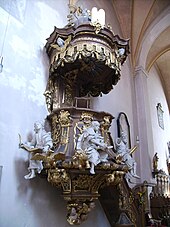Tückelhausen Monastery
The Tückelhausen Monastery is a former Carthusian monastery . Tückelhausen is an incorporated suburb of Ochsenfurt in Bavaria . Since the secularization , most of the property has been used privately. The Cartusian monastery is almost completely preserved. The Carthusian Museum gives an insight into the history of the Franconian Carthusian monasteries and the everyday life of the monks.
history
High Middle Ages
A Liège chronicle names a pilgrimage to the mountain of St. Lambert in Tückelhausen. Remains of the Lambertus Chapel with a Romanesque portal are preserved in the courtyard of an agricultural property that is adjacent to the staircase leading from the village into the Thierbach valley.
Premonstratensians
Unknown noblemen founded a Premonstratensian monastery in the years before 1139 with the support of Bishop Otto von Bamberg . The nuns were transferred to Lochgarten near Bad Mergentheim , 20 km away, in 1144 . Due to the insufficient material resources, the monastery often had to struggle with economic problems. The aristocratic members of the convent defended their independence from the Oberzell monastery . In 1305 nuns were accepted again, this time from Michelfeld Abbey near Kitzingen. In 1307 the canons were moved to Oberzell to maintain discipline, until the abolition in 1349 the monastery of the "Sisters of the Mountain of St. Lambert" was inhabited by nuns alone.
Carthusian
In 1349 Tückelhausen was sold to the Würzburg cathedral dean Eberhard von Riedern, who wanted to found a charterhouse. But only after his death in 1351 was Tückelhausen handed over to the Carthusians for use as "cella salutatis". Her life was marked by silent work and numerous daily prayers . In the second half of the 14th century, considerable renovation work was carried out so that each monk could be assigned his own little house with a garden plot. The Carthusian monks lived in a mixed observance that linked being a hermit with elements of community life. The cells consisted of a long row in the form of small houses. The cloister provided access to the monk's cell , which had a living and study room and a small house chapel. A hatch to the cloister served to supply the monks with food. For Vigil , Matutin , morning mass and Vespers , the monks gathered in the church, which had been specially rebuilt for their purposes: the north and south transepts had been separated from the single nave nave of the church. In the former transepts, the Carthusians accommodated an oratory, the chapter house, the archive and the library. During the rest of the day they went on their hermit life and prayed for themselves in their cells. The monks devoted themselves particularly to the study of the Holy Scriptures and the copying of books.
War devastation
In the Peasants' War in 1525 and in the Markgräfler War in 1552, there was considerable devastation and looting. In 1561 the Charterhouse was fortified with a curtain wall. In the course of the Reformation, many Carthusians left the community. At the beginning of the 17th century, the Charterhouse was able to consolidate again. From 1613 to 1616 the church was redesigned in the Mannerist style. During the Thirty Years' War further damage was done by the Swedes. In the campaign of 1673 the French plundered Tückelhausen.
18th century
Extensive construction work began in 1694 and stretched over several decades. First the economic wing and later a new priory building and a guest wing were built. There was also a large wine cellar . The wine was grown in the Thierbachtal. In 1720 the remarkable baroque pulpit was built into the monastery church , followed by the rococo high altar and the carved choir stalls in the middle of the 18th century. The high altar comes from the Würzburg workshop of the court sculptor Johann Wolfgang von der Auwera .
secularization
In the course of secularization , the Charterhouse was abolished in 1803. The monastery church became a parish church. Since then, most of the property has been used privately.
Carthusian Museum
Pastor Robert Rakowitz opened a Carthusian Museum in 1991. The diocese of Würzburg has been the sponsor of the museum since 1997. The museum gives an insight into the history of the Franconian Carthusian monasteries and shows the everyday life of the monks. You can visit the reconstructed Carthusian house with the small garden, the cloister and the chapter house. Contemporary works of art are on display in the former library.
literature
- Michael Koller, Jürgen Lensen: Carthusian Museum Tückelhausen. A museum of the Diocese of Würzburg. Kunstverlag Josef Fink, Lindenberg 1997, ISBN 3-931820-41-6 .
- Thomas Horling: Foundation and early days of the Premonstratensian Monastery Tückelhausen (before 1139-1172) , in: Zeitschrift für Bavarian Landesgeschichte 68 (2005), pp. 441–484 ( digitized version ).
- Erik Soder v. Güldenstubbe: Tückelhausen , in: Monasticon Cartusiense , ed. by Gerhard Schlegel, James Hogg, Volume 2, Salzburg 2004, 339–344.
Web links
- The Carthusian Museum at the Diocese of Würzburg
- Tueckelhausen
- Tückelhausen Monastery , basic data and history: From the Premonstratensian Foundation to the Carthusian Museum in the database of Monasteries in Bavaria in the House of Bavarian History
Coordinates: 49 ° 39 '9.4 " N , 10 ° 1' 30.7" E





